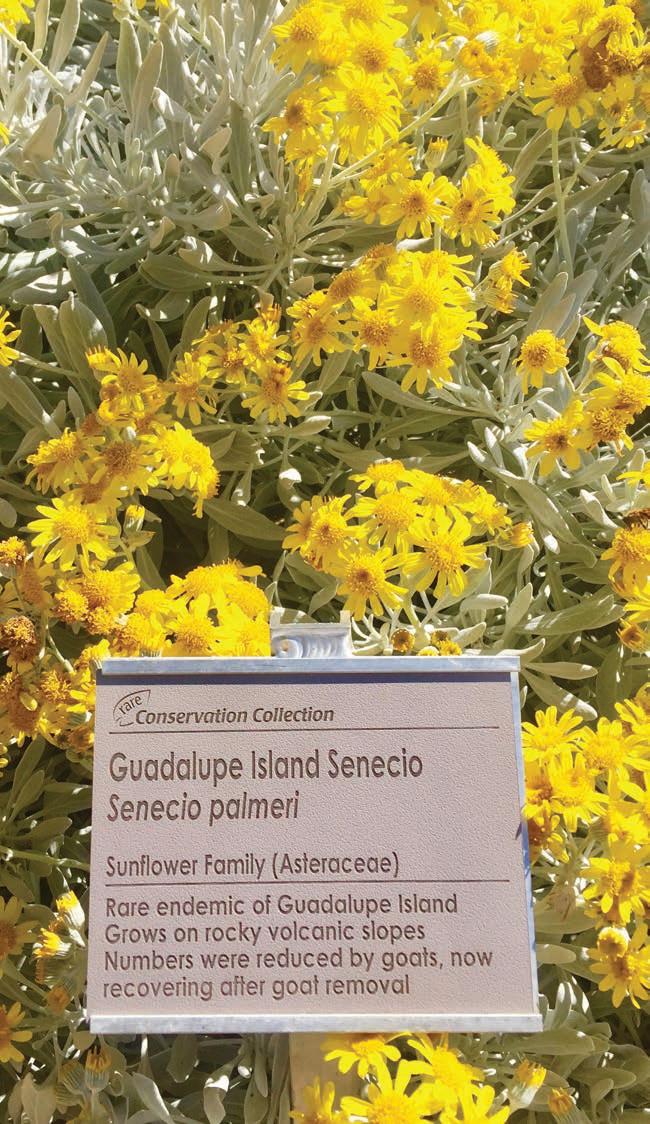
4 minute read
A Garden for the People
A Garden for the people
There is no doubt that living and working in the time of COVID-19 has changed our priorities and made us all adapt in ways we couldn’t have imagined. But the Garden’s mission has proven to be more urgent than ever, and our community has made it clear that having the Garden as a space for outdoor recreation and education has provided much-needed relief. While we had no choice but to pause classes and most in-person tours since March of this year, the Garden has been able to showcase our collections to record numbers of members, local families looking for ways to spend time outside, and brand-new audiences stopping by on road-trips across the state.


The Garden’s Education department has taken this opportunity to engage a broader audience in our mission by increasing onsite opportunities for learning. Caitlin Lam, Lifelong Learning Coordinator & Registrar, is improving and adding to the Garden’s interpretive signs that complement our living collections and challenge visitors to take a closer look at what surrounds them. This gives us a chance to communicate with people throughout the grounds, pointing out seasonal standouts, the phenomena of California plants, and the big picture of the work that the Garden does that could otherwise be missed. Caitlin seeks to orient new visitors to what they are seeing perhaps for the first time and share new insights with longtime visitors and members. After all, the Garden’s guests should have the right to be informed, engaged, and also challenged by their experiences here.
As an accredited living museum and model botanic garden, we document our plant collections for research and conservation, and present them to the public to educate and further their understanding of our work. One of the Garden’s driving motivations is to inspire the next generation of conservationists and protectors of our environment. Education that reaches people where they are and connects them to a larger purpose is how we make that vision a reality. Over our nearly 95-year history, we have grown and diversified our gardens to be a resource for people of all ages, backgrounds, and experiences.

Caitlin has added new display labels, some with common and scientific names of plants and others with text describing interesting or distinctive aspects of the plant. The goal of these additions and updates is to provide educational information that will speak to a broad audience, including children, people who are new to thinking about the world of plants or are unfamiliar with California natives, and plant enthusiasts always looking for more information. The Education department hopes that the display labels will spark an interest or deepen a fascination with plants that encourages a personal relationship with the natural world. This type of passive, didactic information may be commonly seen in art or science museums, but there is an important balance to be reached at a botanic garden where the beauty of natural spaces is so prized.
As a conservation organization, we need to inform and inspire our community to take action and support the conservation of our native plants and habitats. A personal connection to nature may be the first step towards a lifelong passion for conservation, and for people who don’t have extensive experience in the outdoors, the Santa Barbara Botanic Garden can be where they take that very first step.
Visitors immediately recognize our iconic California poppies and Coast redwoods, but with over 1,000 different plant taxa (groups of organisms) displayed in distinct habitats, the Garden is home to both common and unique specimens. We seek to improve to the public’s understanding of the incredible biodiversity of the California Floristic Province with some help from these onsite education opportunities. Communicating the basics about our collection can allow visitors to feel more comfortable before taking a next step like registering for a class or looking up more information on their own. Moving people from a general awareness to a personal commitment to conserving native plants can make a real impact.
“I’m trying to create an opportunity for anyone at any phase in their plant love journey to go deeper and to spark more interest or curiosity,” says Caitlin.
Species that are rare, endangered, and endemic to the Channel Islands are displayed along the sides of the Pritzlaff Conservation Center. Here visitors can enjoy sweeping views of Santa Cruz and Santa Rosa islands, learn about the many threats to these special plants, and take a peek inside the labs where our Conservation & Research team works to protect them. Our collections act as insurance against extinction while informing visitors about what threatens native plants and how we can all help.

To help Education best serve visitors, take a survey on your experiences in the Garden by contacting Caitlin Lam at clam@sbbg.org










